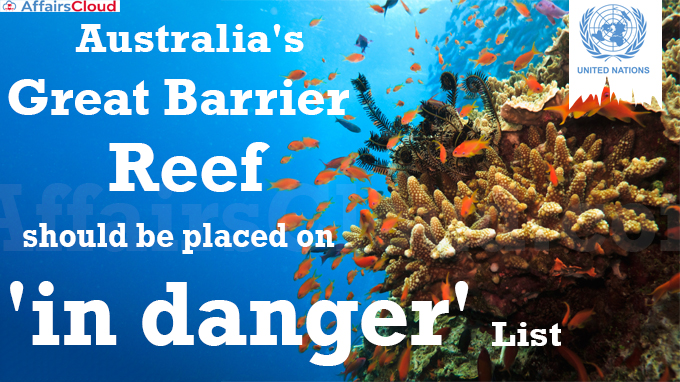
- This recommendation has been made as the reef is significantly impacted by climate change and warming of oceans.
- However, this recommendation of ‘in danger’ status will be considered with submissions from the Federal and Queensland governments (Australia) before UNESCO makes a final decision on its status.
The report followed the UNESCO’s 10-day visit to reef in March 2022. It made 22 recommendations, 10 of which must be addressed with utmost urgency. The report is written by experts from the International Union for Conservation of Nature (IUCN) and UNESCO.
- The properties are included in the list of World Heritage in danger in accordance with Article 11 (4) of the Convention.
Highlights from Report:
i.GBR is faced with major threats that could have deleterious effects on its inherent characteristics.
ii.The acidity of its water has increased 26%, and water quality targets have not been met.
iii.There are frequent bleaching events affecting the reef due to the warming oceans due to the burning of fossil fuels, and acidification. There was widespread bleaching in 1998, 2002, 2016, 2017, 2020 and 2022.
- Notably, it was the first time that the GBR suffered a bleaching event during a La Nina phenomenon of 2022, which typically brings cooler temperatures.
- Bleaching happens when the water warms too much, causing corals to expel the colourful algae living in their tissues and turn white.
iv.The report recommended urgent action to stop sediment runoff, a ban on destructive gill net fishing and a reduction in runoff from banana and sugarcane farming.
Key Points:
i.Corals can survive a bleaching event but can stunt their growth and affect reproduction.
ii.Australian Government has pledged to spend A$1.2 billion ($800 million) in coming years to protect the reef.
iii.It is also committed to reducing Australia’s Greenhouse Gas Emissions (GHGs) by at least 43% from 2005 levels by 2030.
iv.Covering an area of 348,000 square kilometres and home to more than 1,500 species of fish and over 400 species of hard corals, the GBR is an extremely critical marine ecosystem on the Earth.
- It also contributes $4.8 billion annually to Australia’s economy and supports 64,000 jobs in tourism, fishing and research,
- Date of Inscription: 1981
v.The UNESCO classifies 52 such sites as in danger in order to encourage action to protect them.
Recent Related News:
i.The Minister of State for Culture Arjun Ram Meghwal represented the Indian delegation at the UNESCO-MONDIACULT 2022 World Conference that was held in Mexico from 28th September 2022 to 30th September 2022.
ii.The UNESCO’s World Teachers’ Day (WTD) is annually observed across the globe on October 5 to celebrate and honour teachers for their contributions to their students. The theme for 2022 is “The Transformation of Education begins with Teachers”.
About the United Nations Educational, Scientific and Cultural Organization (UNESCO):
Director-General– Audrey Azoulay
Headquarters– Paris, France
Members– 193 Members & 11 Associate Members
Establishment– 1945 (came into force in 1946)